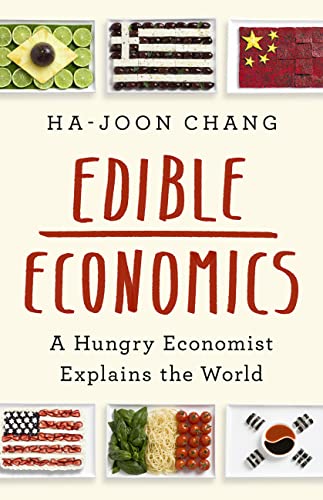Edible Economics, by Ha-Joon Chang
Jun 12
2023

Ha-Joon Chang's Edible Economics: A Hungry Economist Explains the World starts off strong. Chang is a well-regarded economist, his prose is simultaneously engaging and easy to follow, and I like the cover art concept (National flags! But made of food!) Unfortunately, the end result is slightly underwhelming—a tasty but thrown-together snack, rather than a well-balanced meal.
The subtitle for this book is a stretch. “A Hungry Economist Uses Food-centric Historical Examples to Debate Standard Capitalist Dogma” would be closer, albeit less catchy. Each chapter of Edible Economics focuses on the history or production of a particular food, which is used to illustrate Chang's opinions on everything from automation to the patent system to neo-liberal Washington Consensus policies. This might sound dry, but Chang's genuine enthusiasm for the foods he's describing and brisk, chatty way of conveying complex economic concepts makes the whole thing slide down surprisingly easily.
Sadly, the other reason Edible Economics slides down easily is because there's not much to it. In his conclusion, Chang mentions that he had written a series of essays on food and economics, some of which he expanded into chapters of this book. He can't have expanded them by much, because even with generous spacing and loads of chapter breaks, Edible Economics clocks in at a mere 168 pages. To be fair, Chang has a gift for explaining complex concepts efficiently, but there was no need to be THIS efficient. In the end, his readers are left with a handful of fascinating trivia, a light dusting of economic theory and analysis, and a sincere desire to try some of his favorite recipes—none of which, alas, were included*. It's plenty readable, but for $26, more than a little unsatisfying.
*Truly, the lack of recipes is a missed opportunity. If nothing else, it would have upped that embarrassingly low page count.
The subtitle for this book is a stretch. “A Hungry Economist Uses Food-centric Historical Examples to Debate Standard Capitalist Dogma” would be closer, albeit less catchy. Each chapter of Edible Economics focuses on the history or production of a particular food, which is used to illustrate Chang's opinions on everything from automation to the patent system to neo-liberal Washington Consensus policies. This might sound dry, but Chang's genuine enthusiasm for the foods he's describing and brisk, chatty way of conveying complex economic concepts makes the whole thing slide down surprisingly easily.
Sadly, the other reason Edible Economics slides down easily is because there's not much to it. In his conclusion, Chang mentions that he had written a series of essays on food and economics, some of which he expanded into chapters of this book. He can't have expanded them by much, because even with generous spacing and loads of chapter breaks, Edible Economics clocks in at a mere 168 pages. To be fair, Chang has a gift for explaining complex concepts efficiently, but there was no need to be THIS efficient. In the end, his readers are left with a handful of fascinating trivia, a light dusting of economic theory and analysis, and a sincere desire to try some of his favorite recipes—none of which, alas, were included*. It's plenty readable, but for $26, more than a little unsatisfying.
*Truly, the lack of recipes is a missed opportunity. If nothing else, it would have upped that embarrassingly low page count.
Posted by: Julianka
No new comments are allowed on this post.
Comments
No comments yet. Be the first!